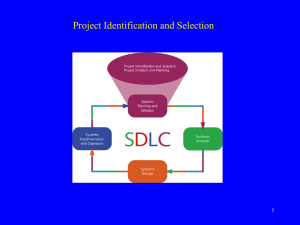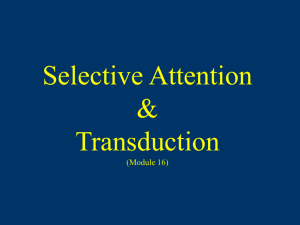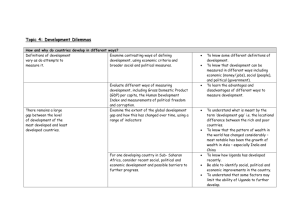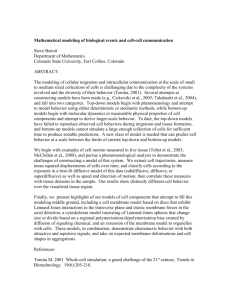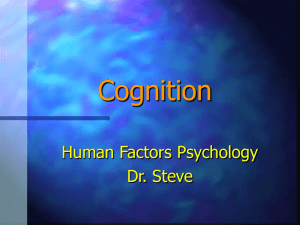Chapter 4 Sensation and Perception Section 1: How we sense and
advertisement
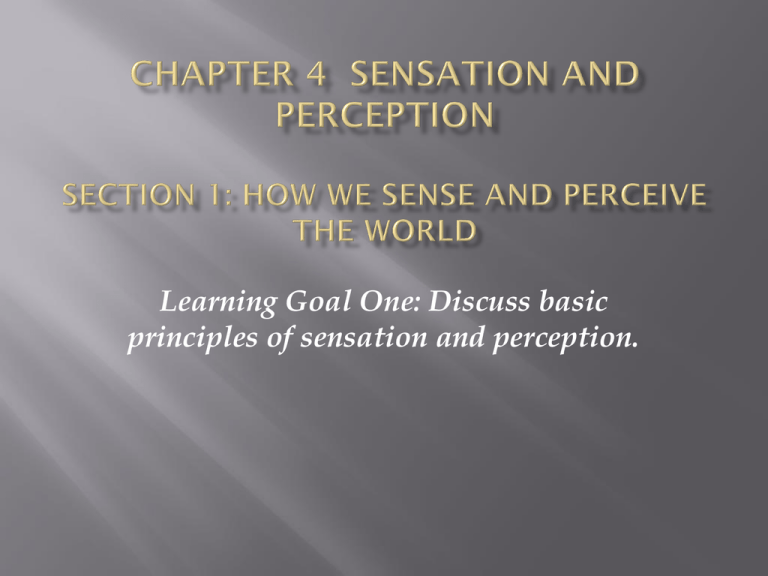
Learning Goal One: Discuss basic principles of sensation and perception. Cornea Transplants Over forty thousand cornea transplants are performed each year. The odds of rejection of the new cornea are low because the cornea has a low blood supply. Abigail was born with congenital glaucoma. At age 2, she had surgery and the gift of sight. Sight was a gift from a sight organ donor. Vision connects us to the world. Sensation occurs when a person receives stimulus energy from the external environment. The process of transferring physical energy into electrochemical energy is called transduction. Perception occurs when a person organizes and interprets sensory information in order to give it meaning. Bottom-up processing occurs when the information from the external environment is registered and sent up to the brain for interpretation. Bottom-up processing occurs with first time information, meaning information that a person is not familiar with. Top-down processing occurs with higher levels of cognitive processing. Top-down processing occurs with information that a person is already familiar with. Is It Top-Down or Bottom-Up? Circle the correct answer. 1. Susie sets up the VCR to tape her favorite television show. TOP-DOWN or BOTTOM-UP 2. Melissa’s mom is showing Rebecca how to make the family favorite of molasses cookies. She walks Rebecca through the recipe stepbystep. TOP-DOWN or BOTTOM-UP 3. Tim decides he is going to start a business of putting bicycles together. He reads the instructions carefully and follows them very closely. TOP-DOWN or BOTTOM-UP 4. It’s been two years and Tim’s bicycle business is doing very well. He can now go through five to eight bicycles a day without looking at any instructions. TOP-DOWN or BOTTOM-UP 5. Jeremy is in his first year of algebra and finds the algebra problems very confusing. He finds that he needs to keep going back to the textbook and seeing what steps are next. TOP-DOWN or BOTTOM-UP 1. Susie sets up the VCR to tape her favorite television show. TOP-DOWN or BOTTOM-UP 2. Melissa’s mom is showing Rebecca how to make the family favorite of molasses cookies. She walks Rebecca through the recipe stepbystep. TOP-DOWN or BOTTOM-UP 3. Tim decides he is going to start a business of putting bicycles together. He reads the instructions carefully and follows them very closely. TOP-DOWN or BOTTOM-UP 4. It’s been two years and Tim’s bicycle business is doing very well. He can now go through five to eight bicycles a day without looking at any instructions. TOP-DOWN or BOTTOM-UP 5. Jeremy is in his first year of algebra and finds the algebra problems very confusing. He finds that he needs to keep going back to the textbook and seeing what steps are next. TOP-DOWN or BOTTOM-UP The purpose of perception is to take information from the outside world and represent it internally. From an evolutionary perspective, the purpose of perception is to adapt to stimuli in order to survive. We are adapted to our environment. Predators have their eyes at the front of their heads and lunch has their eyes to the side to get away! Sensory receptors are cells that detect and transmit information to sensory nerves in the brain. Sensory receptors set off action potentials in sensory neurons, which then carry the information to the central nervous system. The sense organs and sensory receptors have three classes based on the type of energy that is being transmitted. first is photoreception, which involves the detection of light. Next is mechanoreception, which is the detection of pressure, vibrations, and movement perceived as touch, hearing, and equilibrium. The third class is chemoreception, which is the detection of chemical stimuli that is detected as smell and taste. On rare occasions senses can become “confused.” Synaesthesia refers to an experience in which one sense induces an experience in another sense. For example, a person might “see” music. https://www.youtube.com/watch?v=vEqmN X8uKlA Phantom limb pain is another case in which senses become “confused.” Individuals who have lost limbs report “feeling” pain in the limb that no longer exists. Psychophysics is the study of linking the physical properties of stimuli with a person’s experience of them. An absolute threshold is the minimum amount of energy needed for a person to detect something. If a stimulus falls below the threshold then a person does not experience it. Under ideal circumstances, a person’s absolute thresholds are very low. The problem is that there is so much noise around people that they cannot detect half of the stimuli that are confronting them. Noise is the term given to irrelevant and competing stimuli. Absolute Threshold …the minimum amount of energy an organism can detect 50% of the time Noise …irrelevant and competing stimuli © 2011 The McGraw-Hill Companies, Inc. © 2011 The McGraw-Hill Companies, Inc. Difference Thresholds just noticeable difference (JND) how much stimulus change is necessary for detection? JND increases with stimulus magnitude Weber’s Law two stimuli must differ by a constant minimum percentage (not a constant amount) to be perceived as different © 2011 The McGraw-Hill Companies, Inc. influence of information below the level of conscious awareness Vicary: EAT POPCORN Strahan: thirsty v. non-thirsty words No drink for 3 hours then after experiment those that saw the drink words did in fact drink. © 2011 The McGraw-Hill Companies, Inc. Signal detection theory focuses on decision making about stimuli while in the presence of uncertainty. It depends on the individual and contextual variations such as fatigue, expectancy, and the urgency of the moment. Information acquisition refers to the information that is produced in a brain scan. Criterion is the basis for making a judgment about the available information. In Signal Detection Theory, there are four possible outcomes: Hit, Miss, False Alarm, and Correct Rejection. Decision “Did I detect something?” information acquisition criterion (basis/motive for judgment) Possible Outcomes hit miss false alarm correct rejection © 2011 The McGraw-Hill Companies, Inc. © 2011 The McGraw-Hill Companies, Inc. Selective attention involves focusing in on a specific aspect of an experience while ignoring the others. Attention is not only selective, but it is also shiftable, meaning that a person can be focusing their attention on one thing, but then switches their attention to something else. The Stroop effect is an example of automatic attention. A person attempts to name the colors in which words are presented, but the words do not state the color of the meaning of the word. For example, the word red would be written in the color orange. A person would have difficulty stating orange when the word is red. © 2011 The McGraw-Hill Companies, Inc. A perceptual set is the predisposition to perceive something in a particular way. Look at the card example on page 107. What is out of place? Children who do not have perceptual sets are more accurate than adults in the text example. Sensory adaptation occurs when there is a change in the responsiveness of the sensory system based on the average level of surrounding stimulation. An example of sensory adaptation is when a person first jumps into a swimming pool. The water is cold and shocking, but after being in the water for a few minutes, the person adapts to the temperature of the water. Is there such a thing as ESP (extrasensory perception)? Over 50 percent of adults in the United States believe in ESP, while others believe these occurrences are simply coincidence. Despite seventy-five years of research, there is no evidence that supports the existence of ESP. However, people in general have difficulties with “random experiences” and often search for answers to help them explain unusual events. When you are finished reflect on the reading and discus with those around you how perceptual sets can be good and bad for society. Do expectations influence perception? Harmless objects or deadly weapons? Ethnicity and perceptual errors …reactions influenced not by personal prejudice but by knowledge of cultural stereotypes Does practice reduce ethnic bias? © 2011 The McGraw-Hill Companies, Inc.
